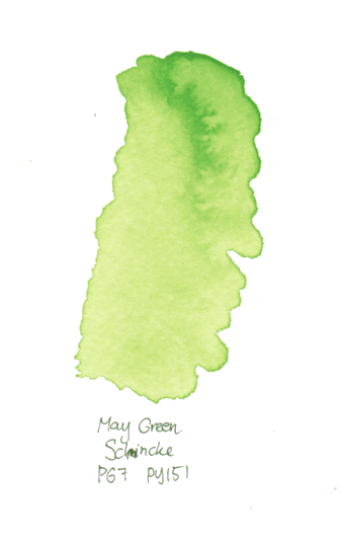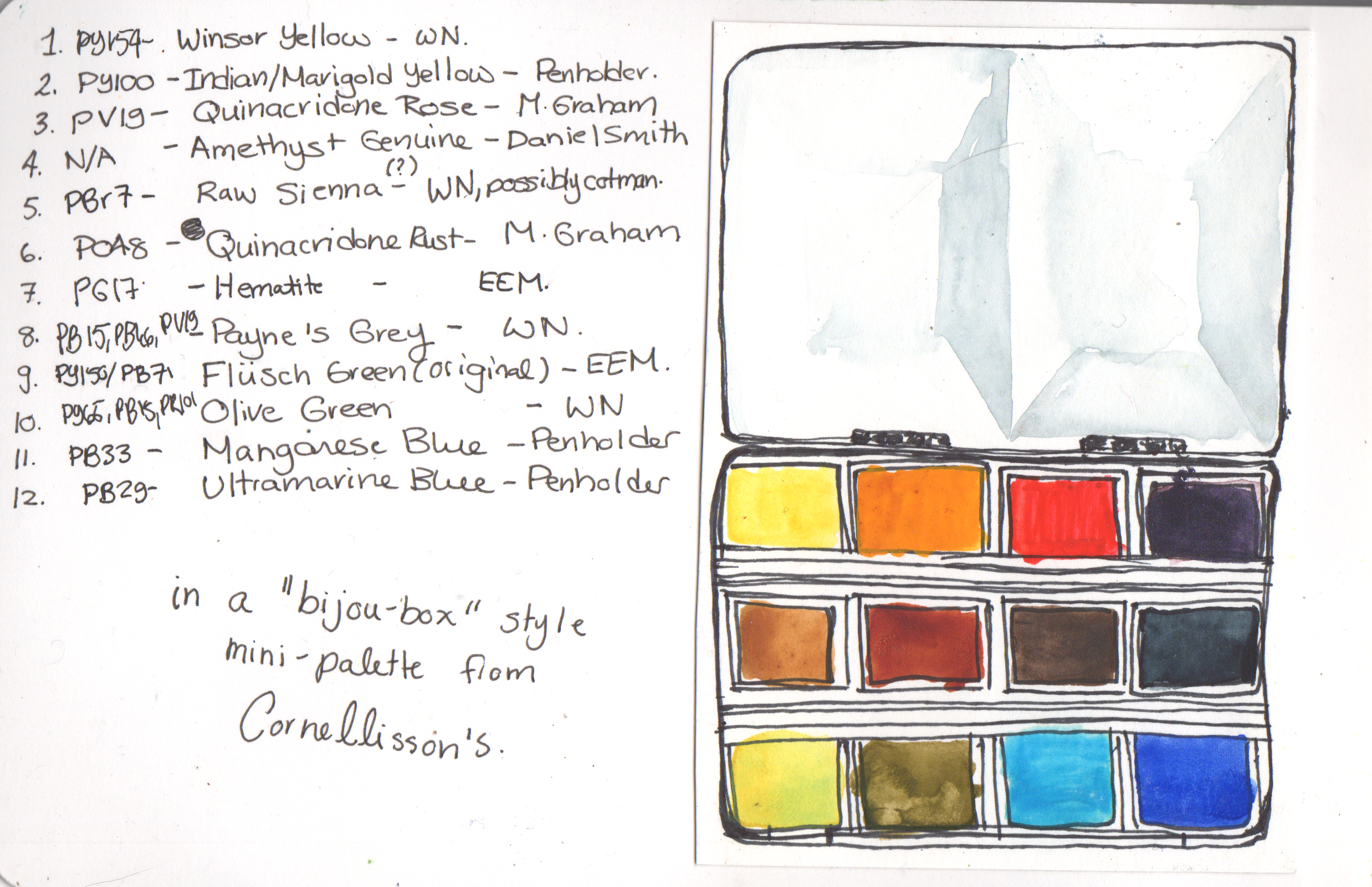If you spend any time with watercolourists, you’ll very soon start hearing some artists who insist that you should only use single pigment colours. At the same time, others will swear by common mixed paints such as Payne’s Grey or Neutral Tint, or rave about wacky special effect mixes such as Daniel Smith’s Imperial Purple. What’s the deal?
In my opinion, there are lots of good reasons to stick with single pigment colours when you first start exploring watercolors, and a few great reasons why you may want to include a few mixed pigments in your collection.
Good reasons to use single-pigment paints:
- Optimize your budget: Most of us can only afford a limited number of paints when we are starting out. With a limited selection of paints, it doesn’t make sense to buy paints that you can mix from other paints you already own. So for example, if you’ve got Phthalo Green (PG7) and Azo Yellow (PY151) then you can mix Schmincke’s lovely May Green (made from PG7 and PY151) from other pigments in your palette, and it may not be the most effective purchase.

May Green by Schmincke, a convenience mix of two greens
That being said, if you can afford it, and May Green makes your heart flutter like it does mine, by all means feel free to buy it. I did. I even made you an affiliate link. For that matter, if it’s the massive full set of 96 Winsor Newton watercolours that sets your heart aflutter, it exists, it’s almost as pretty as it is expensive, and I have a link for that too.
- Single Pigments (often) mix more reliably: Individual pigments each have their own characteristics. Some are transparent and staining, others are opaque and granulating. Black pigments tend to dull mixes, and white pigments will haze over in washes. Some mixed pigment paints are created out of two pigments with similar behaviours (for example, many brands sell a mixed-pigment Phthalo Turquoise made from Pthalo Blue and Phthalo Green, with all the same transparent, staining, easily mixing properties). However, many mixed pigment paints are mixes of granulating/opaque pigments with transparent ones, or they are a pastel shade formulated with white, or they have black added in to darken. When these paints are added to mixes or layered, their behaviour is harder to predict than single pigment paints. They may act in unexpected ways, or separate into their components.
- It is easier to learn colour mixing and paint behaviour with fewer, brighter colours: Do as I say, not as I do. Although I am now overflowing my 52-pan main palette (including 49 distinct single pigment paints),

Juggling my paint collection to fit new pigments into my 52-pan mega palette.
I strongly believe that great colour mixing skills come with being very intimately familiar with the behaviours of your paints and learning how to match colours from a limited palette. Choosing only a few pigments to learn with makes this way easier, and the brightest and clearest mixing paints for a limited palette are mostly single pigments. Trying to learn and keep track of the properties and mixes between a giant and evolving selection of paints has been a lot of work. I buy paints because I love testing and collecting all the pretty colours, but I long ago passed the point where getting new paints was helping me make better art.
- Learning about pigments will help you be an informed shopper: Many brands have cute names for their paints (such as Marine Blue, or Geranium Red). Different brands will offer the same pigment but use different names. or use the same name to describe different pigments. If your paints are mostly single-pigment, and you know their pigment numbers, you won’t fall into the trap of buying a cool-looking colour it turns out you already have from a different brand. You’ll also be able to watch for sales, and mix and match your brands knowing which pigments you are looking for.
Great Reasons to add mixed-pigment paints
- Your absolute favourite colour is just not available as a single pigment: Each of us has some colours that just make us happy. If you’re lucky, there’s a pigment just for you. However, not all colours have a corresponding pigment. For example, the May Green above is one of my favourite colours with special meaning to me. There is no single pigment that colour, but it makes me happy having it on my palette.
- There are two colours you find yourself mixing all the time, and you’d like a shortcut: Do you always mix Ultramarine Blue (PB29) and Burnt Sienna (PBr7) to make neutrals? It might make sense to have a pan of that mix to reach for. Or maybe you’re a floral painter and would like a violet made from PR122 and PB60. Whatever the reason, if having a mixed pigment shortcut on your palette makes your life easier, add one. You can even mix your own in empty pans.
- You paint in a very graphic/bold/pastel style and don’t care about mixing: If you like making art that has flat even areas of pastel mint and lilac, by all means get some Holbein pastel shades of watercolor. If you paint in moody neutrals, reach for that Payne’s grey. If you paint everything in block colours and don’t like mixing, get a nice big set of whatever and don’t worry about pigments. These paints exist because they are useful to some artists.
- An alternative to a colour you’ll only use for mixing: As discussed in point 1, I love insanely bright, springy greens. Sure, I could mix them, but generally that requires a very cool shade of yellow. I don’t like cool yellows, generally, and I especially don’t like how opaque most of the pigments are. I don’t use a cool yellow for anything else. I’ve decided to simply not have a cool yellow on my palette, and keep 1-2 mixed-pigment bright yellow-greens on my palette instead. Unconventional, but it works for me.
- Special effect Paints: Many artists love special effect paints like Daniel Smith’s Imperial Purple and Cascade Green, mixes of pigments that are intentionally made to separate and granulate on the page, creating interesting texture in juicy sky or landscape washes. They’re not really designed for mixing, but they are stunning on their own. These can be easily mixed from common pigments, but that can be a bit of a hassle if you will be doing so frequently. If you love granulating effects paint, it may be worth it to have a couple on your palette.
I think that seeking out single pigment paints is a great strategy for beginners in watercolour to get familiar with their paints and the medium on a budget. With such a dazzling array pigments available to the modern artist, it is usually not limiting to stick with single pigments.
Once you are more familiar with the medium, however, and are attracted to specific multi-pigment mixes, there are good reasons to not be a purist. Practice responsible pigment mixing!
This post contains affiliate links. Lee Angold is a participant in the Amazon Services LLC Associates Program and the Jackson’s Art Affiliate Network. These are affiliate advertising programs designed to provide a means for sites to earn advertising fees by linking to product listings.



